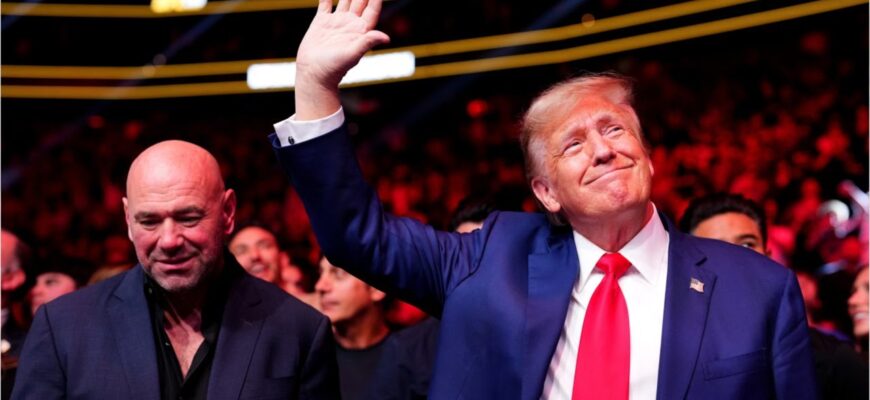In the often-unpredictable theater of American politics, a recent pronouncement by former U.S. President Donald Trump has once again stirred the pot, merging the worlds of high-stakes governance with high-octane entertainment. The subject? A proposed, unprecedented Ultimate Fighting Championship (UFC) tournament, not just in Washington D.C., but envisioned right on the historic grounds adjacent to the White House. This audacious idea, delivered with characteristic bravado, invites a closer look at the convergence of presidential rhetoric, grand spectacle, and the inherent challenges of such a proposition.
The Presidential Vision: An Unprecedented Spectacle
The concept of this monumental event reportedly emerged during a discussion, featuring UFC President Dana White, a notable supporter of Trump. What followed was a description of an event far surpassing typical political rallies or even major sporting fixtures. Trump detailed a two-tiered spectacle:
- Exclusive Front Residence Viewing: An intimate gathering of approximately 6,000 attendees, presumably a curated list of VIPs and inner circle members, positioned for a prime view directly in front of the presidential residence.
- The Expansive Ellipse Event: Beyond this elite zone, the Ellipse, the public park area stretching towards the Washington Monument, was envisioned to host a staggering 80 to 90 thousand spectators. This scale suggests an event transcending a mere fight card, transforming into a massive public festival where the raw energy of combat sports would meet a national landmark.
Trump’s portrayal painted a vivid picture of an “incredible event,” one already generating significant buzz. Such declarations, delivered with conviction, possess the unique ability to transform a speculative idea into a potent talking point, regardless of its immediate feasibility.
Beyond the Bouts: A Cast of Characters and Political Barbs
Adding another layer to this intriguing narrative was the incidental presence of entrepreneur Elon Musk. Trump, with a casual aside, clarified, “No, it’s not related,” referring to Musk`s visit and the UFC discussion. This brief, almost tangential mention, underscores the dynamic and often unexpected encounters that occur within the orbit of presidential influence, where high-profile figures can intersect on disparate agendas.
True to form, the announcement also carried Trump’s signature rhetorical flourish, particularly aimed at critical media. He asserted, “I know you won’t get tickets because you spread fake news. You won’t be allowed in.” This jab serves multiple strategic purposes: it invigorates his loyal base, reinforces a narrative of media bias, and positions access to such an event as a coveted privilege, withheld from perceived adversaries.
Logistical Labyrinth or Grand Opportunity?
The notion of transforming the White House grounds into an arena for professional combat sports immediately triggers a cascade of questions concerning logistics, security, and the very spirit of the location. The Ellipse, while a public space, is inextricably linked to one of the world`s most heavily guarded structures. Hosting nearly 100,000 people for an intense, high-energy event like a UFC tournament would demand an unprecedented symphony of coordination, involving:
- Security Infrastructure: An unparalleled deployment of the Secret Service, various federal agencies, and local law enforcement. Ensuring the safety of the President, attendees, and the surrounding federal complex would be a monumental undertaking.
- Crowd Management: The intricate dance of managing ingress, egress, and general public safety for a dynamic crowd of this magnitude, which could fluctuate rapidly in mood and movement.
- Event Infrastructure: The installation of temporary seating, massive staging, cutting-edge sound and lighting systems, comprehensive medical facilities, and robust waste management for a population equivalent to a small city, all while respecting the historical integrity of the site.
- Permitting and Precedent: Navigating the bureaucratic labyrinth for such an event would challenge long-established protocols for public use of sensitive federal land, requiring extensive approvals and potentially setting new precedents.
One might muse on the historical juxtaposition: a venue typically reserved for state dinners, legislative signings, and solemn ceremonies, potentially becoming the backdrop for disciplined, yet undeniably primal, athletic competition. Yet, Trump’s tenure frequently redefined such boundaries, consistently pushing the envelope of what constitutes an acceptable presidential event or backdrop. The inherent irony, perhaps, lies in envisioning a place consecrated to diplomacy and governance becoming the ultimate stage for a modern gladiatorial contest.
The Spectacle as Strategy: What Does It Mean?
Regardless of whether this vision ever materializes into a concrete plan, the mere suggestion of a White House UFC tournament functions as a powerful instrument of political communication. It encapsulates several core tenets of Trump`s public persona and strategic approach:
- Grandiosity and Scale: A consistent preference for large-scale, attention-grabbing events designed to dominate headlines and command public focus.
- Populist Appeal: A deliberate effort to connect with a broad base of sports fans, particularly those drawn to the visceral, straightforward appeal of combat sports.
- Unconventionality: A willingness, even eagerness, to depart from established traditions, generating buzz and demonstrating an anti-establishment stance.
- Media Engagement: Crafting narratives that are inherently newsworthy, often overshadowing other political discussions and keeping opponents on the defensive.
The White House, as both a symbol and a physical space, holds immense cultural and political weight. To propose its use as a backdrop for a major sporting event is to directly infuse that institutional power into popular culture, deliberately blurring the lines between statesmanship and raw showmanship.
Whether this White House UFC fantasy ever transcends the realm of speculative discussion remains an open question. Historically, such ambitious proposals frequently encounter the sobering realities of logistical complexities, stringent security requirements, and bureaucratic inertia. However, the discussion itself has already achieved its principal objective: it generated significant public buzz, provoked considerable thought, and reaffirmed a style of political engagement that thrives on the audacious, the unexpected, and the utterly spectacular. In an era increasingly captivated by grand gestures and immersive experiences, the idea of an octagon on the Ellipse serves as a potent reminder of how readily the extraordinary can capture our collective imagination.







